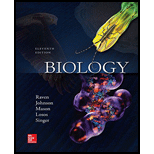
Concept explainers
What property distinguished Mendel’s investigation from previous studies?
a. Mendel used true-breeding pea plants.
b. Mendel quantified his results.
c. Mendel examined many different traits.
d. Mendel examined the segregation of traits.
Introduction:
Mendel initiated his experiment on plant hybridization using specific differences between the pea plants. The differences are comparable. For example, he recognized the inheritance of round seeds versus the inheritance of wrinkled seed. Mendel conducted his experiments in three stages; self-cross in a chosen pea plant variety, crossing of true-breeding varieties displaying alternative forms of traits, hybrid offspring production by letting them self-fertilize for several generations. Mendel counted the numbers of offspring displaying each trait in each subsequent generation. He quantified the results obtained from crosses through mathematical analysis, which led to the inheritance model that is studied until now.
Answer to Problem 1U
Correct answer:
Mendel is concerned with well define traits at a particular time, quantifying the offspring and analyzing the result mathematically. Therefore, option b. is correct.
Explanation of Solution
Reason for the correct statement:
There were five features of Mendel’s breeding experiments that were critical to his success, such as controlled crosses, use of pre-breeding strains, selection of dichotomous traits, quantification of results, and use of reciprocal and test cross.
Option b. is given as “Mendel quantified his result”.
As “Mendel was not the first to study patterns of inheritance but he was the first to use true-breeding strains as parent and to quantify the results that involve well defined variation in characteristics of pea plant in every successive generation”, it is the right answer.
Hence, option b is correct.
Reasons for the incorrect statements:
Option a. is given as “Mendel used true-breeding pea plant”.
T. A. Knight in 1823 performed cross between two varieties of the garden pea; one variety with green seeds, and the other with yellow seeds. Both varieties were true-breeding, and the offspring produced from self-fertilization remained uniform in every generation. Therefore, it is the wrong answer.
Option c. is given as “Mendel examined many different traits”.
Many other investigators made observations similar to Mendel using different traits with alternative forms of observed traits that are being distributed among the offspring. Therefore, it is the wrong answer.
Option d. is given as “Mendel examined the segregation of traits”.
One of the modern geneticists experimented the alternative forms of traits that were segregating among the progeny of a mating, observes that some offspring exhibited one form of a trait (yellow seeds), and other offspring from the same mating exhibited a different form (green seeds). Therefore, it is the wrong answer.
Hence options b., c., and d. are incorrect.
Conclusion:
The quantification of the results obtained from hybridization experiments in pea plant was the property that distinguished Mendel’s investigation from previous studies.
Want to see more full solutions like this?
Chapter 12 Solutions
Biology
- students in a science class investiged the conditions under which corn seeds would germinate most successfully. BAsed on the results which of these factors appears most important for successful corn seed germination.arrow_forwardI want to write the given physician orders in the kardex formarrow_forwardAmino Acid Coclow TABle 3' Gly Phe Leu (G) (F) (L) 3- Val (V) Arg (R) Ser (S) Ala (A) Lys (K) CAG G Glu Asp (E) (D) Ser (S) CCCAGUCAGUCAGUCAG 0204 C U A G C Asn (N) G 4 A AGU C GU (5) AC C UGA A G5 C CUGACUGACUGACUGAC Thr (T) Met (M) lle £€ (1) U 4 G Tyr Σε (Y) U Cys (C) C A G Trp (W) 3' U C A Leu בוט His Pro (P) ££ (H) Gin (Q) Arg 흐름 (R) (L) Start Stop 8. Transcription and Translation Practice: (Video 10-1 and 10-2) A. Below is the sense strand of a DNA gene. Using the sense strand, create the antisense DNA strand and label the 5' and 3' ends. B. Use the antisense strand that you create in part A as a template to create the mRNA transcript of the gene and label the 5' and 3' ends. C. Translate the mRNA you produced in part B into the polypeptide sequence making sure to follow all the rules of translation. 5'-AGCATGACTAATAGTTGTTGAGCTGTC-3' (sense strand) 4arrow_forward
- What is the structure and function of Eukaryotic cells, including their organelles? How are Eukaryotic cells different than Prokaryotic cells, in terms of evolution which form of the cell might have came first? How do Eukaryotic cells become malignant (cancerous)?arrow_forwardWhat are the roles of DNA and proteins inside of the cell? What are the building blocks or molecular components of the DNA and proteins? How are proteins produced within the cell? What connection is there between DNA, proteins, and the cell cycle? What is the relationship between DNA, proteins, and Cancer?arrow_forwardWhy cells go through various types of cell division and how eukaryotic cells control cell growth through the cell cycle control system?arrow_forward
 Human Heredity: Principles and Issues (MindTap Co...BiologyISBN:9781305251052Author:Michael CummingsPublisher:Cengage Learning
Human Heredity: Principles and Issues (MindTap Co...BiologyISBN:9781305251052Author:Michael CummingsPublisher:Cengage Learning Biology Today and Tomorrow without Physiology (Mi...BiologyISBN:9781305117396Author:Cecie Starr, Christine Evers, Lisa StarrPublisher:Cengage Learning
Biology Today and Tomorrow without Physiology (Mi...BiologyISBN:9781305117396Author:Cecie Starr, Christine Evers, Lisa StarrPublisher:Cengage Learning Human Biology (MindTap Course List)BiologyISBN:9781305112100Author:Cecie Starr, Beverly McMillanPublisher:Cengage Learning
Human Biology (MindTap Course List)BiologyISBN:9781305112100Author:Cecie Starr, Beverly McMillanPublisher:Cengage Learning Concepts of BiologyBiologyISBN:9781938168116Author:Samantha Fowler, Rebecca Roush, James WisePublisher:OpenStax College
Concepts of BiologyBiologyISBN:9781938168116Author:Samantha Fowler, Rebecca Roush, James WisePublisher:OpenStax College
 Biology (MindTap Course List)BiologyISBN:9781337392938Author:Eldra Solomon, Charles Martin, Diana W. Martin, Linda R. BergPublisher:Cengage Learning
Biology (MindTap Course List)BiologyISBN:9781337392938Author:Eldra Solomon, Charles Martin, Diana W. Martin, Linda R. BergPublisher:Cengage Learning





